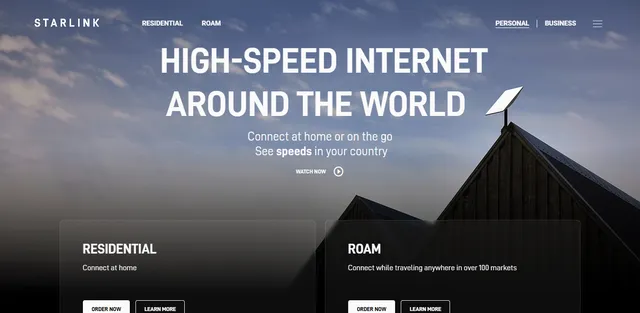
Starlink is a satellite internet constellation founded by Elon Musk. The service is engineered by SpaceX, leveraging its expertise in launch services and orbital operations, with a focus on scalability and global coverage. The platform offers residential, roam, and business plans, with a user-friendly setup process involving a two-step installation: plugging in the equipment and pointing it at the sky, requiring an unobstructed view of the sky. The Starlink app helps determine the best install location, ensuring optimal performance. As of 2025, Starlink is available in over 100 markets, with plans to expand further, making it a game-changer for connectivity in underserved regions.
What is Starlink?
Starlink is a satellite internet service. Run by SpaceX, it is designed to bring fast internet to places where traditional services can’t reach, like remote villages or rural areas. Starlink stands out as a pioneering satellite internet service, offering high-speed, low-latency connectivity for remote areas.
Key Features of Starlink
Starlink’s suite of features is designed to provide reliable and fast internet, with the following key aspects:
- Global Coverage: Current availability in over 100 countries.
- High-Speed Internet: Offers speeds up to 200 Mbps.
- Low Latency: Due to the LEO satellites, Starlink promises latency as low as 20ms.
- Easy Setup: Users can set up the service with a simple two-step process: plugging in the equipment and pointing it at the sky, requiring no technical expertise.
- Flexible Plans: Offers residential, roam, and business plans, including Fixed Site, Maritime, Aviation, and Land Mobility plans, catering to diverse needs.
- 30-day Trial: Allows users to try the service and return it for a full refund if not satisfied.
Use Cases of Starlink
Starlink’s technology is applied across various scenarios, with specific use cases including:
- At Home: For rural homes needing reliable internet.
- On the Go: For travelers or digital nomads needing internet anywhere.
- For Work: Businesses in remote areas can stay connected.
- On Water or Air: Ships and planes can get online.
- In Emergencies: Helps in disaster zones with temporary internet.
Pros and Cons of Starlink
Pros:
- Wide Coverage: Available in over 100 countries, with plans to expand further.
- High Speeds: Significantly faster than traditional satellite internet, with speeds up to 200 Mbps.
- Low Latency: Better than geostationary satellite internet, with latency as low as 20ms.
- Easy Installation: User-friendly setup process, requiring minimal technical knowledge.
- Scalability: Can be scaled up as more satellites are launched, with over 4,000 currently in orbit.
Cons:
- High Cost: Initial equipment cost is high around $599.
- Weather Sensitivity: Performance can be affected by heavy rain, snow, or wind.
- Customer Service: Some users report difficulties with customer support.
 Starlink Reviews & Ratings: See What Users and Experts Are Saying
Starlink Reviews & Ratings: See What Users and Experts Are Saying
 Starlink FAQ: Learn How to Use It, Troubleshoot Issues, and More
Starlink FAQ: Learn How to Use It, Troubleshoot Issues, and More
Starlink is expanding rapidly but is not yet available everywhere.
The initial equipment cost is $599, with monthly subscriptions starting at $99 for residential plans.
Speeds up to 200 Mbps with latency as low as 20ms
Yes, with the Roam plan, which allows users to take their Starlink kit with them.
Yes, due to its lower latency and higher speeds, making it more suitable for modern internet activities.
Starlink is unavailable in India; awaiting regulatory approval.
Starlink speeds up to 200 Mbps; 5G up to 2 Gbps.
Fiber faster than Starlink; up to 8 Gbps vs 220 Mbps.
While Starlink leads in LEO satellite internet, alternatives include Viasat, HughesNet, Traditional ISPs (e.g., Comcast, AT&T), and 5G Home Internet.







